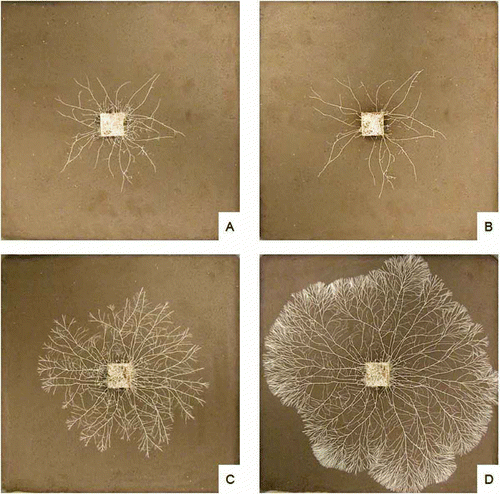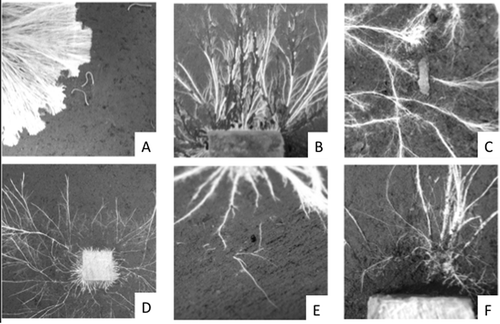Figures & data
Table 1. Mean percentage effects of different invertebrate grazers on hyphal coverage, extension rate and wood decay rate of cord–forming basidiomycete fungi compared to un-grazed controls growing in 2-D soil microcosms
Figure 1. Digital images of Phallus impudicus growing from 2 × 2 × 1 cm wood blocks across 2D soil microcosms. Images show a poorly interconnected system after 1 (A) and 10 (B) days of collembola (Folsomia candida) grazing and a highly interconnected network after 1 (C) and 10 (D) days of grazing. Interconnected systems were less affected by grazing.

Figure 2. 15N excess (mean ± SE) of inner (a) and outer (b) zone mycelia, and inner (c) and outer (d) zone soil across the 32-day study period. Treatments are ungrazed (◊) and grazed (⧫) systems. 15N excess values at t 0 (▵) are immediately before grazing commenced. Significant time × grazing treatment interactions (RM ANOVA) are indicated; *p ≤ 0.05. Note different y-axis scales. Figure modified from Tordoff et al. (Citation2011).

Figure 3. Outcomes of competitive fungal interactions with Resinicium bicolor (Rb) against Hypholoma fasciculare JH (Hf JH), Hypholoma fasciculare DD3 (Hf DD3) and Phanerochaete velutina (Pv) in soil during control (C), Folsomia candida (Fc), Oniscus asellus (Oa), Blaniulus guttulatus (Bg) and Panagrellus redivivus (Pr) grazing treatments. “Draw” indicates that neither fungus replaced its opponent. Stars indicate significant differences (logistic regression) compared to un-grazed controls (***p ≤ 0.001, **p ≤ 0.01, *p ≤ 0.05). Figure modified from Crowther et al. (Citation2011d).

Figure 4. Digital images showing grazing styles of millipede, Blanniulus guttulatus, on Hypholoma fasciculare (A), woodlouse, Porcellio scaber, on Resinicium bicolor (B), Panagrellus redivivus on Phanerochaete velutina (C), Folsomia candida (D), Euzetes globulus (E) and Enchytraeus crypticus on R. bicolor (F). Figure modified from Crowther et al. (Citation2011a).
